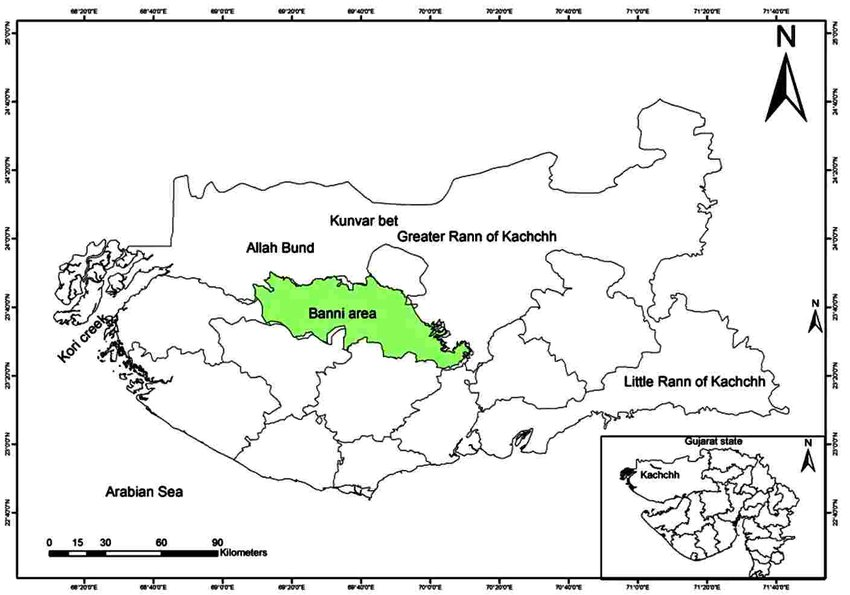Social Justice
NGT Upholds Rights of Pastoralists in Banni Grasslands
- 25 May 2021
- 5 min read
Why in News
The National Green Tribunal (NGT) ordered all encroachments to be removed from Gujarat's Banni grasslands within six months.
- The court also said the Maldharis (Pastoralists) will continue to hold the right to conserve the community forests in the area, granted to them as per the provisions in Section 3 of Forest Rights Act (FRA), 2006.
National Green Tribunal
- It is a specialised body set up under the National Green Tribunal Act (2010) for effective and expeditious disposal of cases relating to environmental protection and conservation of forests and other natural resources.
- NGT is mandated to make disposal of applications or appeals finally within 6 months of filing the same.
- The NGT has five places of sittings, New Delhi is the Principal place of sitting and Bhopal, Pune, Kolkata and Chennai are the other four.
- Being a statutory adjudicatory body like Courts, apart from original jurisdiction on filing of an application, NGT also has appellate jurisdiction to hear appeal as a Court (Tribunal).
Key Points
- About Banni Grassland:
- Location:
- Banni is the largest grassland of Asia situated near the Great Rann of Kutch in Gujarat.
- It is spread over 2,618 kilometres and accounts for almost 45% of the pastures in Gujarat.
- Ecosystem and Vegetation:
- Two ecosystems, wetlands and grasslands, are mixed side by side in Banni.
- Vegetation in Banni is sparse and highly dependent on rainfall.
- Banni grasslands, traditionally, were managed following a system of rotational grazing.
- Banni is dominated by low-growing plants, forbs and graminoids, many of which are halophiles (salt tolerant), as well as scattered tree cover and scrub.
- The area is rich in flora and fauna, with 192 species of plants, 262 species of birds, several species of mammals, reptiles and amphibians.
- Reserve Forest:
- In 1955, the court notified that the grassland will be a reserve forest (the most restricted forests classified according to Indian Forest Act 1927).
- In 2019, the tribunal ordered to demarcate the boundaries of the Banni grassland and restricted non-forest activities.
- Wildlife Institute of India (WII) has identified this grassland reserve as one of the last remaining habitats of the cheetah in India and a possible reintroduction site for the species.
- Location:
- About Maldharis:
- Maldharis are a tribal herdsmen community inhabiting Banni.
- Originally nomads, they came to be known as Maldharis after settling in Junagarh (mainly Gir Forest).
- The literal meaning of Maldhari is keeper (dhari) of the animal stock (mal).
- The livestock include sheep, goats, cows, buffalo, and camels.
- The Gir Forest National Park is home to around 8,400 Maldharis.
- Provisions of the Forest Rights Act 2006:
- Under the provisions of the Act, forest dwellers cannot be displaced unless the rights settlement process has been completed.
- Moreover, the Act has a special provision for setting up ‘Critical Wildlife Habitats (CWH)’, for the conservation of the species.
- It strengthens the conservation regime of the forests while ensuring livelihood and food security of the FDST (Forest Dwelling Scheduled Tribes) and OTFD (Other Traditional Forest Dwellers).
- The Act identifies four types of rights:
- Title rights: It gives FDST and OTFD the right to ownership to land farmed by tribals or forest dwellers subject to a maximum of 4 hectares.
- Use rights: The rights of the dwellers extend to extracting Minor Forest Produce, grazing areas etc.
- Relief and development rights: To rehabilitate in case of illegal eviction or forced displacement and to basic amenities, subject to restrictions for forest protection.
- Forest management rights: It includes the right to protect, regenerate or conserve or manage any community forest resource which they have been traditionally protecting.





